新目标七年级下册
人教版新目标七年级英语下册 Unit 2教学设计
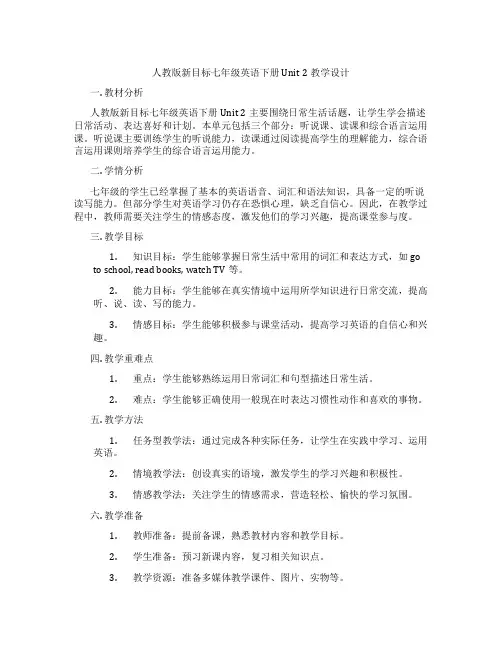
人教版新目标七年级英语下册 Unit 2教学设计一. 教材分析人教版新目标七年级英语下册Unit 2主要围绕日常生活话题,让学生学会描述日常活动、表达喜好和计划。
本单元包括三个部分:听说课、读课和综合语言运用课。
听说课主要训练学生的听说能力,读课通过阅读提高学生的理解能力,综合语言运用课则培养学生的综合语言运用能力。
二. 学情分析七年级的学生已经掌握了基本的英语语音、词汇和语法知识,具备一定的听说读写能力。
但部分学生对英语学习仍存在恐惧心理,缺乏自信心。
因此,在教学过程中,教师需要关注学生的情感态度,激发他们的学习兴趣,提高课堂参与度。
三. 教学目标1.知识目标:学生能够掌握日常生活中常用的词汇和表达方式,如goto school, read books, watch TV等。
2.能力目标:学生能够在真实情境中运用所学知识进行日常交流,提高听、说、读、写的能力。
3.情感目标:学生能够积极参与课堂活动,提高学习英语的自信心和兴趣。
四. 教学重难点1.重点:学生能够熟练运用日常词汇和句型描述日常生活。
2.难点:学生能够正确使用一般现在时表达习惯性动作和喜欢的事物。
五. 教学方法1.任务型教学法:通过完成各种实际任务,让学生在实践中学习、运用英语。
2.情境教学法:创设真实的语境,激发学生的学习兴趣和积极性。
3.情感教学法:关注学生的情感需求,营造轻松、愉快的学习氛围。
六. 教学准备1.教师准备:提前备课,熟悉教材内容和教学目标。
2.学生准备:预习新课内容,复习相关知识点。
3.教学资源:准备多媒体教学课件、图片、实物等。
七. 教学过程1.导入(5分钟)利用图片或实物展示日常生活中的人物和活动,引导学生谈论他们的日常喜好。
例如,展示一张学校操场上的图片,让学生描述图片中学生在做什么。
2.呈现(10分钟)教师通过PPT展示本节课的主要词汇和句型,如go to school, read books, watch TV等,并用例句展示如何运用这些词汇和句型。
人教版新目标七年级英语下册Unit10教案
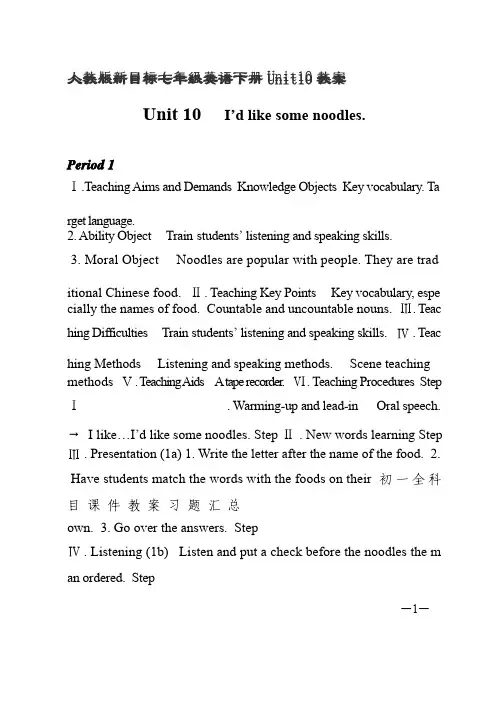
—1—人教版新目标七年级英语下册Unit10教案Unit 10I’d like some noodles.Period 1 Ⅰ.Teaching Aims and Demands Knowledge Objects Key vocabulary. Ta rget language. 2. Ability Object Train 2. Ability Object Train students’students’students’ listening and speaking skills. listening and speaking skills.3. Moral Object Noodles are popular with people. They are trad itional Chinese food. Ⅱ. Teaching Key Points Key vocabulary, espe cially the names of food. Countable and uncountable nouns. Ⅲ. Teac hing Difficulties Train hing Difficulties Train students’students’students’ listening and speaking skills. listening and speaking skills. Ⅳ. Teac hing Methods Listening and speaking methods. Scene teaching methods Ⅴ. T eaching Aids A tape recorder . Ⅵ. Teaching Procedures Step Ⅰ. Warming-up and lead-in Oral speech.→ I like I like…I’…I’…I’d like some noodles. Step d like some noodles. Step Ⅱ. New words learning Step Ⅲ. Presentation (1a) 1. Write the letter after the name of the food. 2. Have students match the words with the foods on their 初一全科目课件教案习题汇总语文数学英语历史地理own. 3. Go over the answers. StepⅣ. Listening (1b) Listen and put a check before the noodles the m an ordered. StepⅤ. Pairwork(1c) Ask students to practice similar conversation s in pairs. Students take turns to be the customer and the noodles ma ker . StepⅥ. Summary and homework Remember the words and practice the target language.Period 2Ⅰ.Teaching Aims and Demands 1. Knowledge Objects Target language Ability Object Train Ability Object Train students’students’students’ listening and speaking skills. Train stude listening and speaking skills. Train stude nts’nts’ communicative competence. Moral Object Noodles are popular communicative competence. Moral Object Noodles are popular with people. They are traditional Chinese food. Ⅱ. Teaching Key Poi nts T h e t a r g e t l a n g u a g e u s e d f o r a s k f o r a n d g i v e p e r s o n a l information. Order food. Ⅲ. Teaching Difficulties Train Train students’students’students’ listening and speaking skills. Train listening and speaking skills. Train listening and speaking skills. Train students’students’students’ commu commu nicative competence. Ⅳ. Teaching Methods Listening and speaking methods. Scene teaching methods Ⅴ. T eaching Aids A tape recorder Ⅵ. Teaching Procedures Step Ⅰ. Warming-up and revision Oral speech and free talk. StepⅡ. Listening (2a 2b) 1. . Listening (2a 2b) 1. YY o u ’r e t o listen and check the names of the foods you hear on the tape. 2. Play the recording twice. Then che ck the answers. 3. P lay th e s ame record ing ag ain. Lis t en carefully and fill in the blanks. StepⅢ. Pairwork (2c,2d) 1. Work with a partner. One is a customer and t he other is a waiter. 2. Invite several pairs of students to act out the ir conversations in front of the class. 3.Have some students role-p lay the conversations in pairs,then explain it to the class. StepⅣ. Grammar Focus G u i d et h e s t u d e n t s t o m a k e s o m e s e n t e n c e s w i t h I ’d , H e ’d and and They’d.They’d.They’d. Step StepⅤ. Conversation practice (3a ,3b) 1. You are to match each question wi th an answer. 2. Get students to do the task in pairs. 3. Put students i nto pairs. One is working in a noodles h o u s e. T h e o t h e r i s t h e c u s t o m e r. G e t t h e p a i r s t o s t a r t t h e activity . Ste pⅥ. Summary and homework 1. S u m m a r yt h e t a r g e t l a n g u a g e w e ’v e l e a r n e d i n t h i s class. 2. Reread the conversa tion in 3a. try to recite it. 3. Write down the conversation in 3c.Period 3Ⅰ. T . Teaching Aims and Demands Knowledge Objects Key vocabulary eaching Aims and Demands Knowledge Objects Key vocabulary . T . Tar ar get language. 2. Ability Object Train get language. 2. Ability Object Train students’students’ listening and speaking skill s. Train s. Train students’students’students’ communicative competence. 3. Moral Object Every communicative competence. 3. Moral Object Every one should choose foods which are good for h is health. Ⅱ. T eachi ng Key Points Learn how to ask for and give personal information an d write down the information. Ⅲ. Teaching Difficulties Learn howto ask for and give personal information and write down the i nformation. Ⅳ. Teaching Methods Practicing methods. Scene teach ing methods Ⅴ. T eaching A ids A tape recorder Ⅵ. Teaching Procedures StepⅠ.Warming-up and lead-in Oral speech. Describe one .Warming-up and lead-in Oral speech. Describe one’’s preferenc es. StepⅡ. New words learning. Porridge onion fish pancake Step Ⅲ. Presentation (1a 1b) 1. Match the words with the pictures. Write the letter of the food on the blank line before its name.2. Circle the things you like in the picture. And make an “×”“×” nex nex t to the things you t to the things you don’t don’t don’t like. Step like. StepⅣ. Listening (1c,1d) 1. Listen carefully and circle in activity 1a th e words that you hear on the tape. 2. Play the same recording again. W Write down the rite down the rite down the customer’s customer’s customer’s address, telephone number and what he or address, telephone number and what he or ders. 3.Check the answers. StepⅤ. Pairwork (2a) 1. Put students into pairs. Ask questions abo ut what they door eat on their birthdays. 2. Invite more advanced students t o demonstrate how to do the activity o demonstrate how to do the activity. Step . StepⅥ.Summary and homework Remember the key words and target la nguage.Period 4Ⅰ. T . Teaching Aims and Demands Knowledge Objects Learn to read and eaching Aims and Demands Knowledge Objects Learn to read and write an ad for House of Dumplings. 2. Ability Object Train student s’s’ reading and writing skills. Train reading and writing skills. Train reading and writing skills. Train students’students’students’ integrating skills. 3. Moral integrating skills. 3. Moral Object Keep healthy. Ⅱ. Teaching Key Points Learn how to order fo od. Learn to write an ad for House of Dumplings. Ⅲ. T . Teaching Diffic eaching Diffic ulties Learn how to order food. Learn to write an ad for House of D umplings. Ⅳ. Teaching Methods reading and writing methods. Practi cing methods Ⅴ. T eaching A ids A tape recorder Ⅵ. Teaching Procedure s Step I. Warming-up and revision Oral speech and dictation. Step II.R eading and answering(2b,2c) Do 2b:Ask students to read the article and complete the c h a r t ,t h e n c h e c k t h e a n s w e r s.E x p l a i n t h e k e y p o i n t s t o the class. D o 2c :H a v e s t u d e n t s r e a d t h e a r t i c l e a g a i n a n d a n s w e r t h e questions,then check the answers. Step III. Reading (3a) Fill in the blank lines, usi ng words from the box. Get students to complete the paragraph on t heir own. Step IV . Writing (3b,3c) 1. W r i t e y o u r o w n a d. P l e a s e u s e t h e a d i n a c t i v i t y 3a a s a model. 2. Us e the sample version in activity 1c to demonstrate how to order a meal. 3.Have some students to read their ads to the class. Step V . P airwork Let students work in pairs to order meal. Students p ractice both roles. Step VI. Summary and homework Order food.Period 5Ⅰ. T . Teaching Aims and Demands Knowledge Objects Reaching Aims and Demands Knowledge Objects R e v i e w t h e n a me s o f f o o d s a n d d r i n k s , t h e t a rg e t l a n g u a g e used to order food, ask for and give personal information and design an ad.2. Ability Object Train 2. Ability Object Train students’students’students’ communicative competence.3. Moral communicative competence. 3. Moral Object Noodles, a kind of fast food, helps save a lot of time. And it ’s ’s delicious and rich in nutrient, thank the inventor. Ask your family delicious and rich in nutrient, thank the inventor. Ask your family members or classmates what they’d they’d like to eat. In this way, you like to eat. In this way, you will understand each other better. Ⅱ. Teaching Key Points Review all the key words and order food. Review to ask for and give person al information. Ⅲ. Teaching Difficulties Order food, design an ad fo r House of Dumplings. Ⅳ. Teaching Methods Practicing methods. Ⅴ. T eaching A ids Ⅵ. Teaching Procedures Step Ⅰ.W arming-up Step Ⅱ. Review the key vocabulary Give students several minutes to me morize the key vocabulary . Large, medium, noodles, beef, mutton, chic ken, cabbage, potatoes, tomatoes, dumplings, soup, green tea, orang e juice. StepⅢ. Self Checks1, 2 ,3 D oS e l f C h e c k 1. A s k s t u d e n t st o c h e c k a l l t h e w o r d s t h e y know. Write five new word s in their V ocab-builder. Do Self Check2. Ask students to complete th—7—e task,then h a v e s o me s t u d en ts r e a d th e 3 co n v e r s at io n s t o t h e c l as s i n pairs. D o S e l f C h e c k 3. A s k s t u d e n t s t o w r i t e a c o n v e r s a t i o n w i t h the help of the clues in pairs,t hen have some pairs read their conversations to the class. StepⅣ. Review the target language Make a conversation use the target la nguage. What kind of noodles would you like?→I’d I’d like beef noodles. What size bowl of noodles would you like? like beef noodles. What size bowl of noodles would you like?→I’d I’d like a small/medium/large bowl of noodles. like a small/medium/large bowl of noodles. like a small/medium/large bowl of noodles. What’s What’s What’s your address? your address? →My address is My address is ….….…. Get several pairs of students to act out their conv Get several pairs of students to act out their conv ersations. StepⅤ.Summary and homework Summary the language .Summary and homework Summary the language we’ve we’ve we’ve learned learned in this unit. Finish 3c as your homework.。
新目标英语七年级下册讲义—Unit 11 How was your school trip
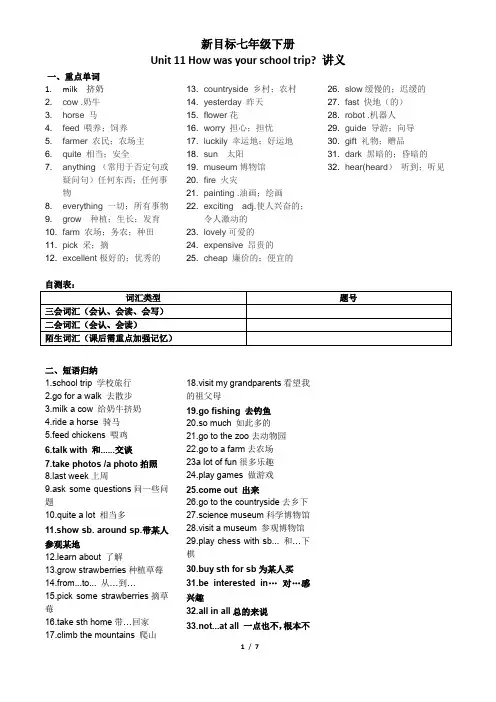
新目标七年级下册Unit 11 How was your school trip? 讲义一、重点单词k 挤奶2. cow .奶牛3. horse 马4. feed 喂养;饲养5. farmer 农民;农场主6. quite 相当;安全7. anything (常用于否定句或疑问句)任何东西;任何事物8. everything 一切;所有事物9. grow 种植;生长;发育10. farm 农场;务农;种田11. pick 采;摘12. excellent极好的;优秀的13. countryside 乡村;农村14. yesterday 昨天15. flower花16. worry 担心;担忧17. luckily 幸运地;好运地18. sun 太阳19. museum博物馆20. fire 火灾21. painting .油画;绘画22. exciting adj.使人兴奋的;令人激动的23. lovely可爱的24. expensive 昂贵的25. cheap 廉价的;便宜的26. slow缓慢的;迟缓的27. fast 快地(的)28. robot .机器人29. guide 导游;向导30. gift 礼物;赠品31. dark 黑暗的;昏暗的32. hear(heard)听到;听见自测表:二、短语归纳1.school trip 学校旅行2.go for a walk 去散步k a cow 给奶牛挤奶4.ride a horse 骑马5.feed chickens 喂鸡6.talk with 和......交谈7.take photos /a photo拍照st week上周9.ask some questions问一些问题10.quite a lot 相当多11.show sb. around sp.带某人参观某地12.learn about 了解13.grow strawberries种植草莓14.from...to... 从…到…15.pick some strawberries摘草莓16.take sth home带…回家17.climb the mountains 爬山18.visit my grandparents看望我的祖父母19.go fishing 去钓鱼20.so much 如此多的21.go to the zoo去动物园22.go to a farm去农场23a lot of fun很多乐趣24.play games 做游戏e out 出来26.go to the countryside去乡下27.science museum科学博物馆28.visit a museum 参观博物馆29.play chess with sb... 和…下棋30.buy sth for sb为某人买31.be interested in…对…感兴趣32.all in all总的来说33.not...at all 一点也不,根本不三、句型集萃1. How + be…? + like? ……怎么样?2. How do/does+主语+feel about...? 对......感觉如何?3. too many + 可数名词复数太多的……4.teach sb. how to do sth. 教某人怎样做某事5.quite + a / an + 形容词+可数名词单数= a + very + 形容词+可数名词单数一个相当/ 很……6.buy sth. for sb.=buy sb. Sth.为某人买东西7.It’s +形容词+to do sth. 做某事是......的8.sound+形容词听起来......四、词汇、句型讲解及拓展1.How was your school trip?学校旅行怎么样?【解析】How+be+主语?=What be+主语+like?意为“….怎么样?”★★★本句的答语:It was great./It was OK./It was/wasn’t good….【拓展】how是疑问副词,意为“怎么样,怎么”,用来构成特殊疑问句,主要用法如下:1)询问如何做某事,或者做某事方式。
(新)人教版新目标七年级英语下册(Unit7-Uni8)集体备课教案设计
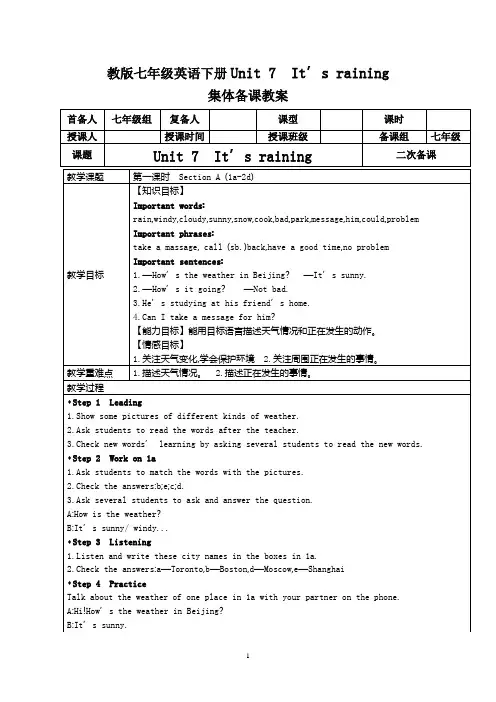
Learn the sentences in Grammar Focus by heart.
板书设计
Section A(Grammar Focus-3b)
重点短语
1.talk on the phone
2.make soup
3.right now
重点句型
1.How’s the weather?—It’s cloudy./ It’s sunny./ It’s raining.
课时
授课人
授课时间
授课班级
备课组
七年级
课题
Unit 7It’s raining
二次备课
教学课题
第二课时Section A(Grammar Focus-3b)
教学目标
【知识目标】
Important word:again
Important phrases:
every Saturday,play basketball,in the park,talk on the phone,make soup,right now,study Chinese
Important phrases:
take a massage,call(sb.)back,have a good time,no problem
Important sentences:
1.—How’s the weather in Beijing?—It’s sunny.
2.—How’s it going?—Not bad.
Keys:1.cloudy2.raining3.sunny4.windy5.snowing
Ⅱ.根据汉语意思完成句子
1.她在公园正玩得开心。
2023年新人教版七年级英语新目标下册教学大纲

2023年新人教版七年级英语新目标下册教学大纲一. 教学目标1. 研究掌握七年级英语下册的全部单词、词组及句型。
2. 建立起对基本语法知识的理解和应用能力。
3. 提高听、说、读、写、译等英语语言应用能力。
4. 培养学生的跨文化交际能力和综合语言运用能力。
二. 教学内容1. 单元研究:本教学大纲包括七年级英语下册全部8个单元的研究内容。
2. 语法知识:研究基本的时态、句型、从句等语法知识。
3. 听力:通过听取各种文本及对话,提高学生的听力理解能力。
4. 口语:培养学生的口语表达能力和交际能力。
5. 阅读:通过课本和其他相关材料的阅读,提高学生的阅读理解和语言运用能力。
6. 写作:培养学生的写作技巧和创造力,使其能够进行基础的句子和段落写作。
三. 教学方法1. 组织互动式教学:通过小组合作、角色扮演、情景训练等方式激发学生的参与和积极性。
2. 情境教学法:通过设置真实的语言环境和情境,提高学生的研究兴趣和应用能力。
3. 多媒体教学:利用多媒体技术,丰富教学内容,提高学生的研究效果和记忆力。
四. 教学评价1. 综合评价:综合考察学生在听、说、读、写、译等方面的表现,通过各种测试形式进行评价。
2. 个性化评价:根据学生的不同需求和特点,给予个体化的评价和辅导。
五. 教学资源1. 教材:新人教版七年级英语新目标下册。
2. 多媒体设备:计算机、投影仪等。
3. 音频材料:相关录音、音乐等。
六. 教学安排1. 按照教材的顺序,每周安排一到两个单元的研究。
2. 每节课根据学生的实际情况,合理安排听、说、读、写等活动。
3. 重点讲解语法知识,并进行相关的练和应用。
以上是《2023年新人教版七年级英语新目标下册教学大纲》的基本框架,根据实际情况和教学需求,可以进行适当的调整和补充。
人教版新目标七年级英语下册 Unit 7 教学设计
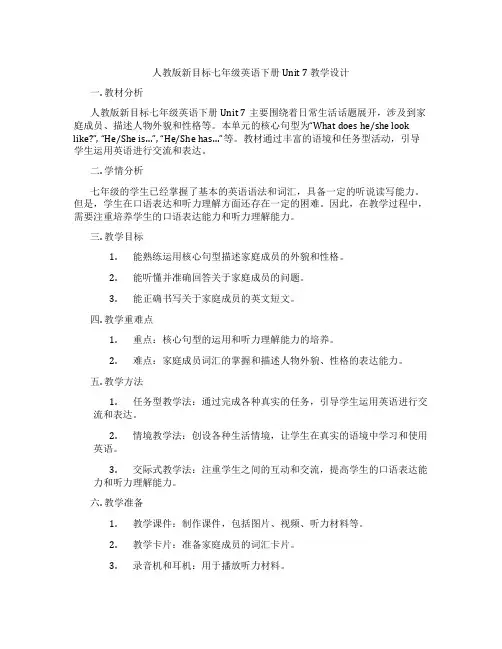
人教版新目标七年级英语下册 Unit 7 教学设计一. 教材分析人教版新目标七年级英语下册Unit 7主要围绕着日常生活话题展开,涉及到家庭成员、描述人物外貌和性格等。
本单元的核心句型为“What does he/she look like?”, “He/She is…”, “He/She has…”等。
教材通过丰富的语境和任务型活动,引导学生运用英语进行交流和表达。
二. 学情分析七年级的学生已经掌握了基本的英语语法和词汇,具备一定的听说读写能力。
但是,学生在口语表达和听力理解方面还存在一定的困难。
因此,在教学过程中,需要注重培养学生的口语表达能力和听力理解能力。
三. 教学目标1.能熟练运用核心句型描述家庭成员的外貌和性格。
2.能听懂并准确回答关于家庭成员的问题。
3.能正确书写关于家庭成员的英文短文。
四. 教学重难点1.重点:核心句型的运用和听力理解能力的培养。
2.难点:家庭成员词汇的掌握和描述人物外貌、性格的表达能力。
五. 教学方法1.任务型教学法:通过完成各种真实的任务,引导学生运用英语进行交流和表达。
2.情境教学法:创设各种生活情境,让学生在真实的语境中学习和使用英语。
3.交际式教学法:注重学生之间的互动和交流,提高学生的口语表达能力和听力理解能力。
六. 教学准备1.教学课件:制作课件,包括图片、视频、听力材料等。
2.教学卡片:准备家庭成员的词汇卡片。
3.录音机和耳机:用于播放听力材料。
七. 教学过程1.导入(5分钟)a.引导学生自由谈论自己的家庭成员。
b.出示一张家庭成员的图片,让学生用英语描述。
2.呈现(10分钟)a.展示教材中的图片,引导学生观察并描述家庭成员的外貌和性格。
b.教授核心句型“What does he/she look like?”, “He/She is…”,“He/She has…”等。
3.操练(10分钟)a.分组进行角色扮演,让学生模拟描述家庭成员的外貌和性格。
b.邀请几组学生上台表演,其他学生进行听力理解练习。
新版新目标英语七年级下册知识点总结
Unit8IsthereapostofficenearhereSectionA1.Therebe 句型(1)Therebe+sb/sth+ 地址在某地有某人或某物there指引词,没有词义;be是谓语动词;某人/物是主语,地址作状语,多为介词短语)Thereisabankintheneighborhood.(2)Therebe 句型的谓语动词be在人称和数上应此后边的第一个名词保持一致就近原则Thereissomesaladonthetable. Therearesomestudentsintheclassroom.Thereisaboyandtwogirlsintheroom.(3)一般疑问句:将be动词提到句首一定回答:Yes,thereis/are.否认回答:No,thereisn ’t/aren’t(4)否认句:在be后加not.(5)Therebe 句型表示客观存在;have/has 表示主观拥有Therebe 句型不可以与have/has 连用。
CenterStreet 在中央大街上onBridgeStreet 在大桥街上在街上inthestreet 英式onthestreet 美式at+ Helivesat99HuayuanStreet.Helivesin/onLongStreet.在街道名称前用介词门牌号on3.payphonepayf or+付电话费pay物付钱买某物v支付,付钱pay+钱+for+物付多少钱买某物4.方向介词的用法:acrossfrom在对面,后接地址名词或代词cross=goacross穿过(指从物体的表面穿过,through穿过(指物体的中间穿过公园丛林)=ontheothersideof/opposite马路桥)5.nextto在..旁边,凑近后接地址名词或代词near在....周边and在和之间(二者之间,人时间数字场所)SheissittingbetweenLilyandLucy.7.infrontofinthefrontof在前方(范围以外)重申在某事物范围以外的前方在..前方(范围以内)重申在某事物范围内的前方me打搅了,对不起屈驾因咨询事情,打搅他人而表示抱歉时的用语,常用在问路以前。
新版新目标英语七年级下册Unit13复习课件
Unit 1 ┃ 易错点针对训练
3. The lady is very good ___t_o____ her cat. 4. If you are not good ____a_t____ driving, you'd
better keep the car away. Ⅳ.使用所给词的适当形式填空 1. The book is very __i_n_te_r_e_s_t_in_g__ (interest). 2. I need a__r_e_la__x_in_g__ (relax) holiday. 3. Are you _i_n_te__re_s_t_e_d_ (interest) in music? 4. He doesn't feel __re__la_x_e_d___ (relax) when he is at
Jim's uncle, Green works on a farm near Sydney. He likes swimming, too. He also wants to work in Hefei. But he can't speak Chinese. So he is still in Australia and goes to Chinese classes every week.
C.but D.for
( A )7.A.with B.and
C.of
D./
( B )8.A.want B.want to C.like D.go
( B )9.A.need B.Call
C.show D.meet
( C )10.A.ID card number B.room number
新目标七下(1教案课件
新目标七下(1-2)教案-课件随着教育信息化的推进,越来越多的学校开始利用课件来辅助教学,目的是让教学更加生动、易于理解,提高学生的课堂参与度和学习效果。
其中,“新目标英语”作为全国中小学英语教学资源,便是以其丰富的教学资源和深厚的英语教学经验,开发了一系列优质的课件,广受师生欢迎。
一、新目标七年级下册(1-2)教案-课件的概述新目标七年级下册(1-2)教案-课件共包含60个教学单元,涵盖了丰富多彩的英语知识。
其中,教学单元中不仅包含了听、说、读、写等基础技能的培养,还通过课程设置,将语言知识与生活实践和文化背景相结合,为学生提供了全面的语言学习和文化素养培养。
1.课程设置教学单元从学生的日常生活出发,以话题为主线设置了一系列具有实用性、趣味性、文化性和启发性的话题,如"Going to a movie", "Family", "Pets"等。
在教学单元的设计上,综合了常见的任务型教学模式和交际教学模式,使学生在语言学习的过程中,不仅培养了语言技能,还增强了学生的交往能力和文化视野。
2.教材编写教材编写方面,新目标英语严格按照 "活生生的英语,活学活用"的原则,突出实用性、语境性和趣味性,经过反复修改、试讲和测试等环节后,呈现给学生的教材已具有良好的排版和图文结合,注重学生的感性认识和逻辑思维的发展,深受广大学生和教师的喜欢。
3.课件制作随着信息技术的不断发展和网络学习的普及,新目标英语课件的应用逐渐成为中小学英语教学的一种常见方式。
此次课件的开发有以下亮点:1)动画效果多,增强学生的视觉感受,使学生更易于理解和接受知识点。
2)题目设置富有启发式和针对性,能够激发学生的思考和兴趣。
3)配图清晰、美观,让学生对课堂内容进行更深入的了解和记忆。
4)配合教材,还原本意,让学生在学习中快速掌握知识点。
二、新目标七年级下册(1-2)教案-课件的实际应用新目标七年级下册(1-2)教案-课件已得到广泛的应用。
新目标七下(3教案:提升学生英文阅读理解的能力
新目标七下(3教案:提升学生英文阅读理解的能力”阅读是英语学习中非常重要的语言技能之一,早期的教育理念更加注重注视阅读发展。
但在近些年,英文阅读变得更加具有挑战性,因为它要求学生们阅读的材料更加丰富、更加复杂,所以每个学生都希望在阅读中获得成功。
如何提高学生的阅读能力? 如何设计有效的教学策略来帮助学生掌握阅读技巧和方法? 鉴于此,新目标七下(3-4)教案的出现,旨在提升学生们的英文阅读理解的能力,促进他们对英语的爱好和兴趣。
一、教学目标1.学生能够掌握阅读理解的基本技能,例如猜测词义和归纳思维等。
2.学生能够理解不同类型的英语文章,例如叙述文、说明文和议论文等。
3.学生能够运用所学的常识和前提条件,并对文章进行准确、全面的理解。
4.学生能在所学英语阅读材料中找出关键信息点,以更好地应对阅读理解题目。
5.学生能通过理解文章的内容和影响,扩展他们的语言知识和应用能力。
二、教学内容1.不同英文文章的分类2.阅读技巧和方法3.词汇和语法知识的运用三、教学策略1.帮助学生识别英语文章的类型。
叙述文、说明文和议论文都有自己的特征,不同类型的文章都有不同的阅读目的,因此了解这些不同类型的文章对学生的英语阅读能力是非常有帮助的。
2.建议学生使用“田忌赛马”的心理学策略。
根据学生的英语阅读水平可以根据基础的文章先阅读,然后逐渐提高难度。
3.让学生自己画图解释文章内容。
通过自己画图,学生们可以更准确地理解文章的意思。
4.帮助学生扩展英语阅读材料的范围。
让学生在阅读教科材料的同时,还可以通过英语新闻、英语文学和英语歌曲等不同源头的英语读物中寻找兴趣爱好。
5.提供清晰的阅读目标和意义。
告诉学生哪些具体的阅读目标可以达到,为他们提供一个明确的上升空间,通过小阶段的成功,逐渐提高他们的英语阅读技巧。
四、教育成果1.提高学生们的英语阅读理解的能力,特别是在对于各种各样阅读材料的阅读技巧和方法掌握上。
2.学生们的英语阅读水平可以得到更好的提高,并且可以通过广泛阅读来扩展他们的语言知识和应用能力。
- 1、下载文档前请自行甄别文档内容的完整性,平台不提供额外的编辑、内容补充、找答案等附加服务。
- 2、"仅部分预览"的文档,不可在线预览部分如存在完整性等问题,可反馈申请退款(可完整预览的文档不适用该条件!)。
- 3、如文档侵犯您的权益,请联系客服反馈,我们会尽快为您处理(人工客服工作时间:9:00-18:30)。
新目标七年级下册
1-6单元短语句型总结Unit 1词组
1.弹吉他
2.在周末
3.下棋
4.说英语
5.去你家
6.在家
7.回家
8.有空
9.也会游泳
10.跟---说
11.练功夫
12.打鼓
13.一些人
14.给我们看你的照
片
15.讲故事俱乐部
16.说英语俱乐部
17.招聘学校表演的
学生
18.与他们交朋友
19.在我们英语方面
帮助我们
20.帮某人干某事
21..拨这号给我们打电话
22.到学生运动中心
来
23.教我们学历史
24.在老人之家需要
帮助25.给他们讲故事
26.参加运动俱乐部
27.说英语的学生
28.来加入我们
29.对---有办法
30.擅长讲故事
31喜欢画画
32.教我们地理
33.给我写信
34.参加学校音乐节
35.忙于游泳
36.使我们高兴
37.使他唱
38.对---有益
39.在音乐室里
Unit 2词组
1.起床早
2.穿上衣服
3.给她穿衣服
4.刷他的牙
5.淋浴
6.去上班早
7.有趣的工作
8.广播电台
9.在晚上
10.进行锻炼
11.做早操
12.一些练习
13.画地好
14.最喜欢音乐家
15.两群人
16.锻炼半小时
17.九点半
18.十点一刻
19.八点差一刻
20.四分之三
21.做我们作业
22.跑步明星
23.步行到学校
24.步行到这儿
25.散步
26.跑地快
27.也不会画
28.或者---或者---
29.你的班主任
30.尝着可口
31.在我的一生中
32.过着幸福的生活
33.他们的生命
34.一个吃早饭的有
趣时间
35.上班迟到
36.吃一顿好的早餐
37.有时间打扫我的
房间
38.从周一到周五
39.给我做早餐
Unit 3 词组
1.乘地铁
2.骑自行车
3.一百零八
4.九百九十九
5.动身去北京
6.乘索道过河
7.开车回家
8.开车去武汉
9.捎她去武汉
10.住在村里
11.公汽停靠点
12.停下来读
13.停止读
14.一小时半
15.过桥
16.过河上学
17.乘索道
18.怕我
19.怕乘船
20.没有桥。
21.多远
22.离你家远
23.五十分钟
24.实现
25.做个梦
26.梦见他
27.住得距学校两公
里远
28.梦见她乘火车
29.开他的车上班
30.骑自行车15分钟
31.我花半小时看书
32.离开枣阳去北京
33.把我的书忘在了家
34.需要一小时到校
35.在我和他之间
36.一位11岁的男孩
37.对我而言像位父
亲
38.看上去像她
39.对船而言流得急
Unit 4 词组
1.遵守规则
2.违反制度
3.上学迟到
4.听老师讲
5.与他打架
6.在外面玩
7.穿制服
8.安静
9.清洗餐具
10.到达枣阳
11.祝你好运。
12.感到幸运
13.保持健康
14.一些头发
15.三根白发
16.学习雷锋
17.学会守纪
18.在课堂上吃东西
19.必须准时
20.在上学日
21.每20分钟
22.做早饭
23.太多的规则
24.早饭前
25.在上学时
26.制定规则
27.练习说英语
28.到达那商店处
29.对某人要求严格
30.对某事要求严格
31.一个使人轻松的故事32.记得做某事
33.记得做过某事
34.我必须做的事情
35.保持房间干净
36.继续看电视
37.在上学的晚上
38.去给爷爷拿食物
39.最好做某事。
Unit 5词组
1.砍伐树木
2.所有种的--
3.有点儿
4.在南方
5.在南非
6.挽救大象
7.节约水
8.浇树
9.象牙制品
10.三千多
11.十万多
12.在河上方
13.睡觉
14.长时间行走
15.在中国南方
16.整天睡觉
17.整年
18.来自非洲
19.什么动物
20.帮它们生存
21.泰国大象节
22.事实和数据
23.由---制成
24.五星红旗
25.聪明且友好
26.对我们友好
27.什么种类的动物
28.泰国的象征之一
29.猎杀大象攫取象牙
30.忘记干某事
31.忘记干过某事
32.处于危险之中
33.用两条腿走路
34.非常喜欢长颈鹿
35.有食物和水的地
方
36.在泰国的重要性
37.如何拯救老虎
38.失去它们的家园
39.一种好运气的象
征
Unit 6词组
1.看报
2.做汤
3.看电影
4.美国
5.端午节
6.错过校车
7.想念他家人
8.打电话交谈
9.想要
10.听CD
11.洗衣服
12.一会见。
13.今天的故事
14.祝你新年愉快
15.希望干某事
16.希望某人干某事
17.祝他们健康
18.用电脑做作业
19.用钢笔写
20.明天晚上
21.购物
22.在家学习
23.他的寄宿家庭
24.东道国
25.考虑
26.包粽子
27.没有地方比得上
自己家
28.和他表哥通电话
29.看起来比她实际
年龄小
30.一个---,另一个---
31.一些---,另一些---
32.任何一天来
33.和我一块吃晚饭
34.在电视上看划船
比赛
35.像其它的任何一
个夜晚
36.给她的孩子们读
故事
37.在游泳池里游泳
38.一位来自深圳的
学生
39.复习准备考试。
